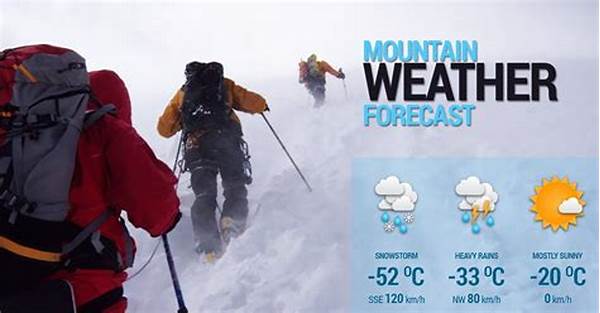Hey there, fellow photography enthusiasts! If you’re like me, the majestic allure of mountains has probably called to you more than once, urging you to capture their magnificence through your lens. But, before you grab your camera, there’s one critical aspect to consider: the weather conditions for mountain photography. It’s not just about clear skies and breathtaking views; it’s about understanding how different weather patterns can transform a simple snapshot into a masterpiece. Let’s dive in!
Read Now : The Role Of Lighting In Professional Portraits
The Role of Weather in Capturing Majestic Mountain Views
When you’re planning a mountain photography trip, taking stock of the weather conditions is vital. Picture this: you’ve hiked to a peak, and despite the strenuous climb, you’re met with fog so thick you can’t even see your hand. Frustrating, right? On the flip side, imagine the thrill of capturing low-hanging clouds gently caressing the mountain tops during a golden-hour sunrise. Weather conditions for mountain photography aren’t just obstacles; they’re dynamic elements that can add drama and depth to your photos.
On a clear day, the vivid blue sky can contrast beautifully with snow-capped peaks or lush green valleys, adding vibrancy to your photos. Plus, the morning and evening light, known as the ‘golden hour,’ often offers the perfect lighting conditions. But don’t let grey, overcast days deter you! These can provide soft, even lighting and minimize harsh shadows. Moreover, mountains often create their own weather patterns, so flexibility and adaptability are key. So, keep an eye on those forecasts, and pack your gear accordingly, knowing every weather condition for mountain photography has the potential to enhance your photo story.
Embracing Unpredictable Weather
Sometimes, the best shots come from the most unpredictable weather conditions for mountain photography. Stormy skies might break apart, revealing shards of sunlight that highlight the terrain. This contrast can create genuinely striking compositions.
Capturing mountains in mist can add a sense of mystery and ethereal beauty to your shots. Don’t shy away from these conditions.
Brave the cold for snow-covered mountains glistening in the sun. A fresh layer of snow can transform a familiar scene into something magical and pristine.
Keep your camera gear protected against sudden rain or snowfall. Weatherproof your equipment so you’re always ready to snap that unexpected masterpiece.
Play with shadows on partly cloudy days. The mix of sunlight and clouds dappled over mountain ranges can create unique patterns and mood in your images.
Preparing for Your Mountain Photography Expedition
Understanding the weather forecast is just the beginning. Preparing for the weather conditions for mountain photography involves a strategic blend of planning and spontaneity. Always have more than one plan because mountains are notorious for their unexpected weather changes.
Flexibility can be your greatest asset. A sudden downpour might not be ideal for portraits, but it could lead to a breathtaking rainbow arching over the peaks. Carrying the right gear is also crucial. A sturdy tripod for stability in windy conditions and lens filters to manage lighting can make all the difference. Don’t forget warm layers and waterproof clothing for yourself too, as comfort plays a huge role during those long waits for the perfect shot.
Engage fully with your environment, and let intuition guide your creativity. The essence of weather conditions for mountain photography lies not just in the outer environment but also in your inner weather—the mood and perspective you bring to your art form. Balance preparation with the willingness to be surprised, and your mountain photography adventures can be as rewarding as the breathtaking images you capture.
Best Times and Techniques for Weather-Driven Photography
Morning and evening times often provide the best weather conditions for mountain photography due to softer lighting. The scenery transforms dramatically during these times, offering rich hues and softer shadows. Use a polarizing filter to enhance these naturally rich colors and minimize glare.
Bracketing your shots can be beneficial. This involves taking multiple shots at different exposures in tricky weather conditions to ensure you capture the perfect balance. HDR processing afterward can help bring out the best in details lost to varying light conditions.
Windy conditions might make things more challenging, but they also offer a chance to test your skills. Steady your shot by using a heavy tripod and consider the dramatic flair wind adds to the landscape, with clouds moving swiftly across the peaks.
Don’t overlook the blue hour—that magical time just before sunrise and after sunset—for dramatic skies and tranquil settings. Use a slow shutter speed to capture the calm ambiance or a fast one to retain the sharpness of bustling elements.
The interplay of rain and light is magical. Look for spots where light pokes through the clouds post-rain, creating divine sunbeams. A waterproof camera housing will ensure that a little rain doesn’t dampen your adventure or your equipment.
Practical Tips to Maximize Your Mountain Photography Experience
1. Always check multiple weather sources to get the most accurate forecast.
2. Learn the microclimates of your chosen mountain area; they can differ from general regional forecasts.
Read Now : Royalty-free High-resolution Picture Repository
3. Use apps to track sunlight, sunrise, and sunset times for perfect shot planning.
4. Pack light but smart—include only essential gear and protective clothing.
5. Always be aware of your surroundings and respect nature to stay safe.
6. Bring snacks and water for energy; hiking for hours can drain you!
7. Practicing patience is key; sometimes, a shot is as much about waiting for the right conditions as it is about clicking the shutter.
8. Protect your camera and lenses with a reliable weather-resistant bag.
9. Carry extra batteries; cold temperatures can deplete power faster than expected.
10. Have fun and be creative; the best shots often come when you’re simply enjoying the experience!
Finding Beauty in Unforeseen Weather
The real magic behind weather conditions for mountain photography often emerges when you embrace the spontaneous elements. Have you ever stood at the meeting place of fierce winds and a peaceful fog? It’s in those surprising moments that creativity can flourish. Such conditions push you to test new techniques and adapt your perspective.
As photographers, we are the storytellers of nature’s tale, and sometimes the most unexpected chapters are the most enlightening. Uneven terrain mixed with unpredictable weather crafts its own storyboard. When photography becomes more about being present in the moment than merely taking the shot, every rate of the landscape is amplified. Sunrises that seemed ordinary might suddenly explode into color, or a simple cloudy day might turn into a moody saga of shadow and light, revealing the mountains in a whole new way.
Embracing the Past and Present Lessons
Experience is the best teacher, especially when dealing with weather conditions for mountain photography. One stormy session might reveal moody landscapes you’ve never dreamt of, while bright sunny escapades flirt with your senses, casting lights and shadows that dance across the terrain. Each weather condition is a teacher, guiding you through color, texture, and sharp contrasts.
Your art is a constant evolution and every snap counts. From knowing where to stand, to adjusting your settings, to finding your own growth pattern—photography is a journey. Though we’ve scientifically broken down the weather into atmospheric pressures and fronts, remember also to trust your gut and your own set screw, letting your contemporary eyes see nature while snapping photos. Mother Nature’s brilliance is waiting as a canvas. Paint it as your heart imagines.
Summary: Weather Conditions and You!
An adventure involving weather conditions for mountain photography is as unpredictable as it is rewarding. Each shift in weather offers fresh perspectives and unique photo opportunities. Cloudy mist, vibrant blue skies, or snowy panoramas are all brushes with flair meant to enhance your artistry.
Take each weather challenge and convert it to an opportunity, because what seems like an impediment may often unveil a hidden gem within your work. Whether you’re a seasoned photographer or a curious newbie, allowing yourself to be flexible can mean the difference between a forgettable picture and a masterpiece. Embrace each forecast and make the best of it with preparation, patience, and a sprinkle of creativity.
In this grand tapestry, let the weather guide you. As you continue on this wild adventure, it’s comforting to know that every condition, each cloud, rain, or beam of light is part of a larger composition meant to enhance your mountain photography narrative. So, grab your gear and let the mountains tell their visual stories through your lens!



